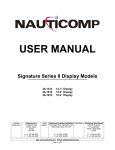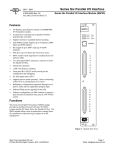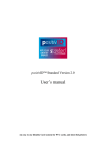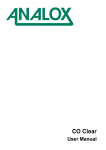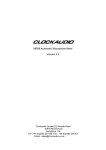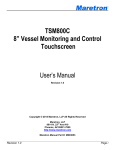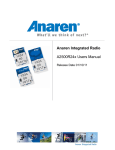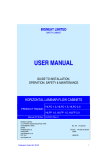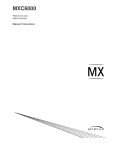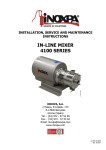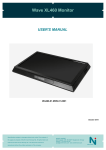Download Centric GB Manual
Transcript
USER MANUAL Centric GB Display Models 23-1510-GB 23-1910-GB 23-2210-GB 23-2610-GB Canadian Nauticomp Inc. Headquarters: 8 Callaghan Road Lindsay, Ontario Canada K9V 4R4 p: +1 705 328 2992 f: +1 705 328 2990 15.0” Display 19.0” Display 22.0” Display 26.0” Display United Nauticomp European Distribution Kingdom: CA Clase 2 Mornington Place, Waterberry Drive Waterlooville, Hants, PO7 7XX United States: Nauticomp International 1200 NE 7th Avenue Fort Lauderdale Florida, United States 33304 p: +44 2392 247920 f: +44 2392 261959 URL: www.nauticomp.com E-Mail: [email protected] p: +1 954 235 4875 f: +1-705-328-2990 TABLE OF CONTENTS 1 GENERAL 1.1 1.2 1.3 1.4 1.5 2 7 7 7 8 9 9 10 11 12 13 Primary Control Functions Overview Menu Mode Centric GB Keypad Functions – Menu Mode On Screen Display (OSD) Tools Menu Functions Menu Picture Menu RGB Mode Wizard Menu Info Menu RS232 Remote Control 14 15 15 16 18 20 22 23 24 25 MAINTENANCE 4.1 4.2 5 Handling Precautions Planning Power Requirements Grounding Cable Runs Display Location EMC Guidelines Mechanical Installation – Display Electrical Installation – Display Recommendations for VGA/DVI Source OPERATION 3.1 3.2 3.3 3.4 3.5 3.6 3.7 3.8 3.9 3.10 4 4 4 5 6 6 INSTALLATION 2.1 2.2 2.3 2.4 2.5 2.6 2.7 2.8 2.9 2.10 3 Forward Display Description Contents of the Package Warnings Important Information Routine Maintenance EMC Servicing and Safety Guidelines 30 30 TROUBLESHOOTING 5.1 Common Symptoms and Possible Solutions -2- 31 TABLE OF CONTENTS continued… 6 SPECIFICATIONS 6.1 6.2 6.3 6.4 23-1510-GB 23-1910-GB 23-2210-GB 23-2610-GB 15.0” 19.0” 22.0” 26.0” Display Display Display Display 32 33 34 35 7 TECHNICAL DRAWINGS 7.1 7.2 7.3 7.4 8 23-1510-GB 23-1910-GB 23-2210-GB 23-2610-GB 15.0” 19.0” 22.0” 26.0” Display Display Display Display 36 37 38 39 APPENDIX 8.1 8.2 8.3 8.4 8.5 8.6 Warranty Certificate Warranty Limitations Return of Goods Information (RMA) Document Revision History Contact Details Product Notes -3- 40 40 41 41 42 43 1 1.1 GENERAL Forward Founded in 1997, Nauticomp Inc. based in Canada designs and manufactures the widest range of watertight sunlight and daylight readable displays for worldwide markets. Nauticomp Inc. is a fully accredited ISO 9001:2000 Company with regional offices located in the United States of America and Europe. The Centric GB Displays have been tested by DELTA Electronics Testing and found to comply with the requirements of the International Association of Classification Societies (IACS) as well as the selected requirements of IEC 60945, IEC 60529 and MIL-STD-810F. In support of the above, we offer the added value of a global network of experienced Dealers and Systems Integrators to ensure customer satisfaction. Please carefully read and follow the procedures stated in this manual. 1.2 Display Description Centric GB displays are a series of approved LCD displays based on a modular concept. The TFT LCD’s used in the Centric GB Series displays range from 15.0” thru to 26.0” sizes. The front, display frame, cover, stand, turntable and sunshade are made of treated aluminium to reduce weight and eliminate corrosion problems. These basic mechanical parts are all constructed and assembled the same way. The electronics include a custom-made power supply, high quality display controller, backlight inverter with sealed transformers and a custom-made interface board. All Centric GB displays use the same power supply and OSD – On Screen Display. The power supply can be supplied with 115 VAC/24 VDC or 230 VAC/24 VDC. The displays can be surface mounted from the front or simply used as a free standing unit using the optional Stand and Turntable. All Centric GB displays have VGA, DVI and RS232 input for remote control purposes. The 19.0” and 26.0” displays also have both S-VHS (S-Video) and CVBS (Composite) video inputs. -4- 1 GENERAL continued… All Centric GB Displays operate from an internal regulated power supply with an external switch converting 115 VAC/24 VDC or 230 VAC/24 VDC. Each Centric Display is shipped with a 2 Year / 24 Month Limited Warranty parts and labour. 1.3 Contents of the Package Each Display is shipped with Description Part Number Qty AC Power Cable 00-0600 1 6ft. Grounded power cable Multi Remote Keypad 00-0107 1 Multi Remote Keypad (Optional) Remote Keypad 00-0106 1 Single Display Remote Keypad VGA Cable 00-0622 1 6ft. 15 Pin D-Sub VGA Cable Front Mounting Kit As Specified 4 4 x M6 screws and screw covers User Manual Manual Rev 6 1 Manual Cut-Out (Paper) Kit Cut-out Rev 1 1 Not to Scale -5- Remarks 1 GENERAL continued… 1.4 Warnings 1.5 1.4.1 Product Installation: All equipment must be installed and operated in accordance with the Nauticomp instructions provided. Failure to do so could result in poor product performance, personal injury and/or damage to connected items. 1.4.2 Electrical Safety: Make sure you have switched off the power before you start installing this product. The display unit contains high voltages. Adjustments require specialized service procedures and tools only available to qualified service technicians. There are no user serviceable parts or adjustments. The user should never attempt to service the equipment doing so will void the products warranty. 1.4.3 Navigation Aid: If this display is used within a navigation system, it is considered as an aid to navigation. Its accuracy can be affected by many factors, including equipment failure or defects, environmental conditions, and improper handling or use. It is the user’s responsibility to exercise common prudence and navigational judgments. This unit should not be relied upon as a substitute for such prudence and judgment. Always maintain a permanent watch so you can respond to situations as they develop. 1.4.4 TFT Colour LCD Displays: The colours of the Display may seem to vary when viewed against a coloured background or in coloured light. This is a perfectly normal effect that will be seen with all colour LCD displays. In common with all Thin Film Transistor (TFT) panels, the screen may exhibit a few (less than 7) wrongly illuminated pixels. These may appear as black pixels in a light portion of the screen, or as coloured pixels in black areas. 1.4.5 EMC Conformance: The design and manufacture of Nauticomp equipment and accessories conform to the appropriate Electromagnetic Compatibility (EMC) standards, but correct installation is required to ensure that performance is not compromised. 1.4.6 User Manual Content: The technical and graphical information contained in this User Manual, to the best of our knowledge, was correct as it went to press. However, our policy of continuous improvement and updating may change product specifications without prior notice. As a result, unavoidable differences between the product and User Manual may occur from time to time. Nauticomp cannot accept liability for any inaccuracies or omissions it may contain. Important Information This User manual contains important information on the installation and operation of your new display. In order to obtain the best results in operation and performance, please read this User Manual thoroughly. Nauticomp’s Technical Support representatives or your local dealer will be available to answer any questions you may have. -6- 2 INSTALLATION 2.1 Handling Precautions The casing of the Display gives good protection to its internal components. To prevent damage to the LCD Display, it is important to observe a few simple precautions. 2.2 2.1.1 Unpack your display carefully to prevent damage. 2.1.2 If the surface is soiled, wipe lightly with clean absorbent cotton or other soft cloth. 2.1.3 The TFT panel and circuit boards contain devices that are sensitive to Electrostatic Discharge. Adequate ESD precautions should be taken during unpacking, handling and installation of the TFT display. 2.1.4 There are no user serviceable parts inside the display. All servicing must be carried out by qualified personnel. 2.1.5 The casing should never be opened by unqualified personnel, as there are potentially harmful voltages within this equipment. 2.1.6 Save the carton and packing in case you need to return the Display for service. Planning Before you install your Display, plan the installation considering: 2.2.1 Display location and mounting options. 2.2.2 Power requirements. 2.2.3 Cable runs - do not run video cables near any AC power sources. 2.3 Power Requirements The display has an internal regulated power supply. With the external switch the display will input 115 VAC/24 VDC or 230 VAC/24VDC. -7- 2 INSTALLATION continued… 2.4 Grounding It is important that an effective RF ground is connected to the display. You must ground the display by connecting the drain (earth) terminal directly on the Nauticomp power supply to the nearest RF ground source (superstructure). The length should be as short as possible. CAUTION: This display is not intended for use on positive ground circuits. The power input cable Earth screen connections must be connected directly to a RF ground source. Recommended Vessel Power Source 24 VDC 115 / 230 VAC Rating of Fuse 5 Amp 10 Amp -8- 2 INSTALLATION continued… 2.5 Cable Runs Consider the following before installing the Display: 2.5.1 All cables should be adequately secured, protected from physical damage and protected from exposure to heat. Avoid running cables through bilges or doorways, or close to moving or hot objects. 2.5.2 Acute bends must be avoided. 2.5.3 Where a cable passes through an exposed bulkhead or deckhead, a watertight feedthrough should be used. 2.5.4 Make sure any excess cable is coiled and secured. 2.5.5 Do not run video cables near AC power sources or wires. CAUTION: Do not ‘Pull’ cables through the bulkheads, walls or tight spaces using a cord attached to the connector. This method could damage the connections. 2.6 Display Location 2.6.1 Viewing angle: This LCD panel has been chosen to give the very best performance, including viewing angle. However, the contrast and colours seen on all LCD displays vary slightly with viewing angle. Note: Viewing an LCD panel from the bottom angle (outside specified display viewing angle characteristic) is typically unacceptable. 2.6.2 Access: There must be sufficient space behind the display to allow cable connections to the rear connectors, avoiding tight bends in the cable. All connections are bottom entry. 2.6.3 Interference: The selected location should be far enough away from devices that may cause interference, such as motors, generators and radio transmitter/receivers (see the EMC guidelines section 2.7). 2.6.4 Magnetic compass: Mount the display unit at least 3 ft (1m) away from a magnetic compass. 2.6.5 Environment: To prevent overheating, do not restrict airflow at the front or rear of the display unit; ensure there is adequate ventilation. -9- 2 INSTALLATION continued… 2.6.6 Heat Management: The display is designed to work within most high ambient heat conditions. There are extreme yet rare conditions that may cause the display to go black or “Blackout”. This is normally caused by concentrated and excessive UV rays (DIRECT SUNLIGHT) acting on the LCD panel. To minimize the risk of the Display being subjected to the above one should endeavour to: - 2.7 2.6.7 Employ additional cooling to assist with heat dissipation. 2.6.8 Provide additional shading. EMC Guidelines All Nauticomp Displays and accessories are designed to the best industry standards for use in the rugged electronic environment. The design and manufacture conforms to the appropriate Electromagnetic Compatibility (EMC) standards (reference section 1.4.5), but correct installation is required to ensure that performance is not compromised. Although every effort has been taken to ensure that they will perform under all conditions, it is important to understand what factors could affect the operation of the product. The guidelines given here describe the conditions for optimum EMC performance, but it is recognized that it may not be possible to meet all of these conditions in all situations. To ensure the best possible conditions for EMC performance within the constraints imposed by any location, always ensure the maximum separation possible between different items of electrical equipment. For optimum EMC performance, it is recommended that where ever possible Nauticomp displays and cables connected should be: 2.7.1 At least 3 ft (1 m) from any equipment transmitting or cables carrying radio signals e.g. VHF radios, cables and antennas. In the case of SSB radios, the distance should be increased to 7 ft (2 m). 2.7.2 More than 7 ft (2 m) from the path of a radar beam. A radar beam can normally be assumed to spread above and below the radiating element. 2.7.3 Supplied from a separate battery from that used for engine start. Voltage drops below 10 V, and starter motor transients, can cause the equipment to reset and or cause the loss of some information and may change the operating mode. 2.7.4 Used with Nauticomp specified cables. Cutting and rejoining (Splicing) these cables can compromise EMC performance and must be avoided. NOTE: If a suppression ferrite is attached to a cable, this ferrite should not be removed. - 10 - 2 INSTALLATION continued… 2.8 Mechanical Installation – Display Mechanical drawings are included in the enclosed with each manual. The display is packaged with all accessories for the ordered mounting type. 2.8.1 Front Mounting The display is mounted to e.g. a console using supplied front mounting hardware enclosed in the delivery. The screws must be tightened to 70 inch pounds / 7.9 Newton meters. Above Illustration –Orientation of bolt and clip located on side of display 2.8.5 Sealing Kit The kit consists of a gasket for the back of the display and rubber O-rings for the mounting screws. The gasket must be inserted into the recess in the display back prior to mounting of the display. Please observe that the gasket is firmly fitted inside the recess all the way around and that the mounting surfaces are clean. Above Illustration –Orientation of Gasket installed on rear of display - 11 - 2 INSTALLATION continued… 2.9 Electrical Installation - Display 2.9.1 Cabling – Electrical Supply All electrical installations are made to the terminals placed on the lower rear side of the display. All terminal designations are marked on the terminal plate beneath the terminals. If the display is exposed to vibration or shock all cables should be fixed to the cable retainers below the terminal plate using plastic tie straps. Connect drain (earth) to the nearest RF ground source (superstructure) Figure1. Terminal Plate for 19” Centric GB Display 2.9.2 Power Supply The display can be supplied by 115 VAC/ 24 VDC or 230 VAC /24 VDC. The selected AC voltage is marked on a label on the terminal plate. The display is connected to AC voltage by means of the standard AC power cable included in the package. The AC current to the display must be limited by a 10 amp fuse or similar. The display is connected to DC voltage by means of DC power plug included in the package. The DC current to the display must be limited by a 5 amp fuse. The wire used must be suitable for up to 8 A. 2.9.3 VGA Cable The VGA cable is included in the package. On the 15.0” and 19.0” displays the VGA cable is to be connected to the VGA terminal. On the 26.0” displays the DVI-I to VGA cable is to be connected thru the DVI-I terminal. Fasten the screws in the terminal for adequate earth connection. 2.9.4 DVI Cable The DVI cable is not included in a standard delivery but is available as an option. The DVI cable is connected to the DVI-I terminal. Fasten the screws on the terminal for adequate earth connection. - 12 - 2 INSTALLATION continued… 2.9.5 Video / Composite Cables Video cables can be connected to the display by means of the S-VHS (S-Video) and CVBS (Composite) terminals. The video cables must be of high quality to avoid interference on the signal. 2.9.6 RS232 Cable The display is equipped with a standard 9-Pin D–SUB connecter for RS232 remote control. Detailed information about this interface and remote control of the display is given in the remote control section. Refer to section (3.10 - RS232 Remote Control) 2.9.8 Cabling – Connections 2.9.8.1 All cables can only be installed one-way. Do not force cables into sockets. 2.9.8.2 All cables must be connected to the output source before connecting to display. CAUTION: Always connect all video input cables before connecting the power. 2.10 Recommendations for VGA/DVI Source All Centric GB Displays comply with VESA DDC1/2B Windows Plug and Play. No driver disks are required. A computer running Windows 2000, XP and later versions may interrogate the display for its technical characteristics. For best results Nauticomp recommends that you set the PC or device to match the “native” resolution, and suggested frequency as suggested in section 6 of this manual. (See specifications for your particular display) Example: 1024 x 768 at 60Hz is the preferred resolution and refresh rate. Unlike CRT Displays, LCD displays do not flicker; hence selecting a higher refresh rate provides no advantage. - 13 - 3 OPERATION The Display is designed to minimize overall physical dimensions to enable multiple Displays to be mounted in close proximity maximizing available space. No user controls are on the actual Display. The Keypad which is an external three button Display Controller used to control the Centric GB Display functionality. 3.1 Primary Control Functions: The Centric GB Display is designed to power up when it receives power. Each button performs a primary control function. Keypad Button – Primary Control Function (non Menu Mode) 1) Displays the OSD menu 2) ON/OFF momentarily press for ON / Press & hold for 6 seconds to turn display OFF – This feature prevents accidental switching off by user. Press the DIAL to scroll through all of the display inputs. Turn the DIAL clockwise to increase the backlight brightness. Turn the DIAL counter-clockwise to decrease the backlight brightness. 3) Caution: Ensure the keypad is connected to the display before the power is applied to the display. Multi Remote Keypad Button – Primary Control Function (non Menu Mode) 1) Displays the OSD menu 2) ON/OFF momentarily press for ON / Press & hold for 6 seconds to turn display OFF – This feature prevents accidental switching off by user. Press the DIAL to scroll through all of the display inputs. Turn the DIAL clockwise to increase the backlight brightness. Turn the DIAL counterclockwise to decrease the backlight brightness. 3) Using the Multi Display remote (Optional): Up to 5 displays can be controlled via one remote. Each display is designated an address of 1 through 5. Control brightness and power of all displays connected using the 1-5 button. Control each display individually by selecting the proper address. Each address has an LED above it. When LED is lit that display is operable. Green LED confirms display has an input and is active. Red LED confirms display is active with no input. - 14 - 3 OPERATION continued… 3.2 - Overview – Menu Mode The OSD is designed with 5 different folders: Tools, Functions, Picture, RGB mode wizard, and Info, each of which has their own menu. Tools Functions Picture RGB Mode Wizard Info The Keypad buttons 1, 2 & 3 (section 3.1 refers) are used to navigate and select the OSD (On Screen Display) settings. 3.3 3.2.1 Momentarily pressing button 1 (MENU) activates the Displays Menu Mode. When this is done the Centric GB Menu is displayed. In Menu Mode the other function for button 1 is: Exit. 3.2.2 In the Menu the functions for button 3 (DIAL) are Scroll, Select and Adjust. Centric GB Keypad Functions – Menu Mode Navigation Function Button ACTIVATE the Menu Mode: MOVE to next folder: ACCESS selected folder: SELECT a Desired parameter/setting: ADJUST parameter/setting: SAVE parameter/setting: Press the Menu button Turn the DIAL Press the DIAL Press the DIAL Turn the DIAL Press the DIAL Detailed description of the OSD menus are listed on the following pages: - 15 - 3 OPERATION 3.4 On Screen Display (OSD) The OSD is activated by pressing the MENU button. If the display is in locked state the OSD can only be activated by pressing the MENU control for 5 sec. (When the menu is locked the Display and Keypad LED’s are at their brightest setting) The OSD menu can be opened and closed by pressing the MENU button. Once the menu has been opened it can be navigated up/down and right/left by turning the DIAL. To be able to adjust the settings, an item has to be active, which is done by pressing the DIAL. - To make adjustments in the OSD, follow these steps: 1. Press the MENU button to activate the OSD. 2. Navigate up and down in the different folders by turning the DIAL. 3. When the desired folder is highlighted, press the DIAL to activate the menu. 4. Navigate by turning the DIAL until the desired control has been reached (and highlighted). To gain adjustment control, press the DIAL. The control will be highlighted and can now be adjusted. 5. Turn the DIAL clockwise to increase the value or counter-clockwise to decrease the value. 6. When the right level has been reached, press the DIAL once again to activate the adjustment and automatically jump one level back. 7. To exit the OSD, press MENU. - The following describes how to adjust the settings for Saturation: 1. Press MENU to activate the OSD 2. Turn the DIAL to navigate up or down until you have selected the folder ‘Source enabling’ (the icon will be coloured). 3. Press the DIAL to activate the folder (the folder will turn blue, and automatically the first menu item in the sub-menu will be selected - in this case the ‘Source enabling’ button) 4. Turn the DIAL to navigate to DVI-A (or other Source input) and press the DIAL to activate. 5. Navigate down by turning the DIAL until you have selected the menu item ‘Saturation’ 6. Press the DIAL to activate the menu item. 7. Turn the DIAL to select the desired value for the saturation 8. Press the DIAL to validate the change - the OSD automatically jumps one level back. - 16 - 3 OPERATION continued… 3.4 On Screen Display (OSD) Figure 3 On Screen Display - Depending on the menu chosen, different types of items can appear: Push button - activates a sub-menu or a function List - a value can be chosen from a list Slide bar – slide the bar to choose the desired level from 0-100% ON/OFF - turns the settings On or Off Information - contains pure text or value information - Folder items, menu items, and sub-menu items exist in three different stages: Inactive - when the OSD is opened all folders, menus, and sub-menus are by default inactive, and the only item that is selected is the ‘Tools’ folder. Selected - when the user navigates through the OSD, part of the selected item is blue. It can not be adjusted before activated (Press ENTER). Activated - the item is activated and can be adjusted. To activate an item, push the ENTER button. - 17 - 3 OPERATION continued… 3.5 Tools Menu Tools Control Function Backlights are used to illuminate displays. In small displays they are often used to increase readability in low light conditions. The OSD allows for the backlight to be dimmed from 100 – 0%. At 0%, the backlight is turned off. Value: 0-100% LED brightness When showing a graphic signal or video signal, the following scaling modes exists: Normal: Scaling mode depends on panel and source signal aspect ratio. This mode preserve the correct aspect ratio of the input signal, so if a 4:3 signal is to be displayed on a 16:9 display this adds black bars on both sides. One to one: 1:1 representation of the input signal. If a 640x480 signal is to be displayed on a 1024x768 panel, you will see the picture centered using 640x480 pixels shown with a black frame around it. Fill all: Regardless of input and output resolutions the input picture is scaled to fit the screen. Zoom: Slightly zoomed video input signal. Used for removing (in part) the black bars on top and bottom of the 16:9 image shown on a 4:3 screen. Auto: This means that for Composite or S-Video signals, provided Wide Screen Signalling (WSS) is available, input signal is automatically scaled depending on the ancillary data transmitted. This is usually sent by TV broadcasters or by DVD players according to the aspect ratio of the video. Anamorphic: For 16:9 signals generated by DVD players (the signal is 16:9 but is stretched to fill the screen with no black bars, so the picture, if displayed on a 4:3 screen, would result in tall people). This will de-stretch the picture so that the given correct aspect ratio is restored. Auto and Anamorphic will only appear if video input has been chosen. Value: Normal, One to one, Fill all, Zoom, Auto and Anamorphic If a still picture is needed, the present frame can be frozen by selecting ON in this property. Value: ON/OFF - 18 - 3 OPERATION continued… 3.5 Tools Menu Sets the duration for the time-out of the OSD menu, that is, how many seconds should pass with menu inactivity before the menu closes. Value: 5-20 sec, No timeout How many seconds the logo will be shown on the display at start-up is adjusted here. Value: 1-20 sec, No logo Sets the time that should pass before the display changes state to power save after input signal is removed. Value: 1-20 min, No timeout. Locks the keypad. To unlock the keypad again, press the MENU button for 5 seconds. Value: ON/OFF WARNING: Do not lock keypad if only IR remote is used. The access is only granted through keypad or RS232, NOT through the IR remote Reinstalls the settings provided by the factory. Note: The OSD menu will automatically close after choosing the ‘Factory Default’ button A setup is a combination of settings adjusted by the user. It is possible to save up to 3 different setup combinations (0, 1, and 2). The procedure is: 1) Adjust the desired settings 2) Enter the ‘Setup selection’ and choose 0, 1, or 2 3) Choose the ‘Save Monitor setup’ Value: 0, 1, or 2 Saves the present settings entered by the user (See explanation above). Recalls the settings depending on which ‘Setup Selection’ is chosen: 1) Choose the desired setup under ‘Setup selection’ 2) Activate the ‘Recall Monitor setup’ button Horizontal position of the OSD menu on the display. Value: 0-100 - 19 - 3 OPERATION continued… 3.6 Functions Menu Functions Control Function The ‘Source enabling’ control decides which input sources should be enabled and which should not. By activating the ‘Source enabling’ button, a sub-menu appears where input sources can be activated or deactivated by choosing the ON or OFF setting. A source has to be set to ON to be able to be adjusted. The list below is for Marlin Basic scalar boards. If a Marlin Single scalar board with extension module is used the list will reflect the inputs present on the Marlin Single plus the extension board. Which source will be shown here depends on which component is set for the ‘Source A’ value under the menu ‘Picture’ (And eventually Source B in case of PIP and Side By Side). A sub-menu will appear with the following parameters: By setting the ‘Color temperature’ to User, a new sub-menu appears: - 20 - 3 OPERATION continued… 3.6 Functions menu Brightness specifies the darkness or lightness of a color. It is measured in percent from black (0) to white (100). At 0% brightness, both hue and saturation are meaningless. Value: 0-100% Contrast is the difference in light intensity between the brightest white and the darkest black. Value: 0-100% Saturation sets the brilliance and purity of a color. A highly saturated hue (pure color) has a vivid, intense color, while a less saturated hue appears more muted and grey. At 0% saturation, hue is meaningless. Value: 0-100% Hue is what most people refer to as color. A blue button has the hue blue. It is the dominant wavelength of a color. Value: 0-100% The color can be set to Default, User, Cold, or Warm: Cold: The predominant tones are blue and violet. Warm: The predominant tones are red and orange. User: Activates the menu items Red, Green, and Blue, where the value can be set between 0-100%. Value: Default, User, Cold, or Warm - 21 - 3 OPERATION continued… 3.7 Picture Menu Picture There are three different display modes: Single: A single picture is shown on the display (default) PIP: Picture In Picture, where a small sub-window shows a second picture. Side by Side: The display is divided into two pictures representing Source A and Source B Value: Single, PIP, or Side by Side If ‘Single’ is chosen as display mode, the following menu appears: It is possible to adjust the settings for one input source at a time. If ‘Source A’ is activated, a sub-menu appears: In this sub-menu the user chooses which input should be active .Their settings are adjusted under the ‘Functions’ menu. If ‘PIP’ is chosen as display mode, the following menu will appear: Source A has already been explained and Source B decides which input should be the second input. Swap sources: Swaps the input sources - Source A becomes the PIP picture and Source B the full size picture. Size: The size of the PIP picture is chosen here. Horizontal position: The chosen value decides where the PIP picture is placed horizontally on the display starting from the upper left corner. Vertical position: The value decides where the PIP picture is placed vertically on the display from the upper left corner. If ‘Side by side’ is chosen, the following menu is displayed: - 22 - 3 OPERATION continued… 3.8 RGB Mode Wizard menu RGB mode wizard - This folder is only shown when an RGB signal is present on a RGB input. Control Function Mode selection is a set of parameters telling the display where and how to display the picture (horizontal total, phase, horizontal resolution, vertical resolution, horizontal position, and vertical position). It is possible to enter up to 10 different mode selections: 1) Activate the ‘Mode selection’ 2) Choose the desired no. 3) Adjust settings under horizontal total, phase, horizontal resolution, vertical resolution, horizontal position, and vertical position. 4) Enter and activate the ‘Save mode parameters’ Value: 0-9 Pure information stating the current resolution and Hz. value: No value - pure text. Automatically sets the resolution, position, and phase of the picture on the display. If new mode parameters have been entered it is possible to delete them by using the ‘Clear’ button. The Horizontal Total should be equal to, or higher than, the horizontal resolution plus horizontal position (See explanation under ‘Horizontal position’). The phase settings stabilize the picture by removing horizontal noise and sharpening the image of characters. The value for the horizontal resolution of the display is adjusted here. The vertical resolution of the display is adjusted here. The chosen value decides where the picture is placed horizontally on the display. Horizontal position is equal to the horizontal front porch + horizontal back porch, which is the field used to specify the number of dummy pixel clocks to insert at the beginning (pulsing the line clock pin) and end of each line or row of pixels before. After the line clock for the previous line has been negated, the value in horizontal back porch is used to count the number of pixel clocks to wait before starting to output the first set of pixels in the next line. The value decides where the picture is placed vertically on the display. - 23 - 3 OPERATION continued… 3.9 Info Menu Info Control Function Information about the software version. Information about the temperature in the Monitor. Information about the voltage entering the print. Information about the voltage internally generated on the print. Information about the voltage supplied for the display. The name and input signal data of the source enabled will be informed here. - 24 - 3 OPERATION continued… 3.10 RS232 Remote Control Menu The remote control uses the RS232 interface on the video controller. ELECTRICAL CONNECTION 9 pin D-SUB female connector with the following pin assignment: Pin 1 2 3 4 5 6 7 8 9 +5 V TX RX - GND - - - GND Interface parameters Baud rate: Parity: Data bits: Start bits: Stop bits: Handshake: 9600 no 8 1 1 no COMMUNICATION PROTOCOL The communication protocol complies with IEC 61162-1 (NMEA): Byte 0 1 2 to 4 5 6 7 to LEN+6 LEN+7 ATT ADR CMD LEN IHC DAT IDC The min message length is 7 bytes and the max message length is 82 bytes. The different bytes are described below - 25 - 3 OPERATION continued… 3.10 RS232 Remote Control Menu Attention (ATT) byte This byte identifies the message start: ATT Description 0x07 Command 0x06 Acknowledge (OK) 0x15 Acknowledge (error) Address (ADR) byte ADR 0xFF 0x00 0x01 0x0F Description All controllers (0 -15) Controller 0 Controller 1 etc. Controller 15 Command (CMD) bytes CMD0 0x42 0x4D 0x56 0x4D 0x54 CMD1 0x52 0x41 0x45 0x43 0x59 CMD2 0x54 0x4E 0x52 0x43 0x50 ASCII BRT MAN VER MCC TYP Description Brightness Manufacturer Version (Monitor) Controller Type Data length (LEN) byte Length of DAT in bytes (0-74 bytes) - 26 - 3 OPERATION continued… 3.10 RS232 Remote Control Menu Inverse Header Checksum (IHC) byte It is a simple 8 bit checksum of the header data (bytes 0 to 5) where a bit-wise inversion has been performed. The checksum must be initialised to 0. The 8 bit sum (without carry) of bytes 0-6 must be 0xFF. IHC = 0xFF – (ATT+ADD+CMD0+COM1+COM2+LEN), where only 8 bits are used. If a message checksum fails the controller will reply with the attention byte 0x15 and no data bytes. Data (DAT) bytes The data bytes will only be send if data length (LEN) is greater than 0. The data bytes are designated DAT0, DAT1, DAT2, etc. Inverse Data Checksum (IDC) byte This byte will only be send if data length (LEN) is greater than 0. It is an 8 bit checksum of the data bytes (bytes 7 to LEN+6) where a bit-wise inversion has been performed. The checksum is initialised to 0. The 8 bit sum (without carry) of bytes 7 to LEN+7 is be 0xFF. IDC = 0xFF – (DAT0+DAT1+DAT2+….), where only 8 bits are used If a message checksum fails the controller will reply with the attention byte 0x15. MESSAGE EXAMPLES The following examples are the typical messages used: Brightness command (BRT) This command is used to change the brightness of the Monitor. Change brightness from 40% to 60% on all controllers (default address setting): ATT ADR CMD LEN IHC DAT IDC 0x07 0xFF 0x42 0x52 0x54 0x01 0x10 0x99 0x66 The brightness data is one byte where 0x00 is min and 0xFF is max. - 27 - 3 OPERATION continued… 3.10 RS232 Remote Control Menu Acknowledge (OK): ATT ADR CMD LEN IHC DAT IDC 0x06 0xFF 0x42 0x52 0x54 0x01 0x11 0x99 0x66 The controller returns the new brightness data – in this case 0x99 = 60%. Acknowledge (error): ATT ADR CMD LEN IHC DAT IDC 0x15 0xFF 0x42 0x52 0x54 0x01 0x02 0x66 0x99 The controller returns the previous brightness data - in this case 0x66 = 40%. Manufacturer command (MAN) This command is used to identify the manufacturer of the Monitor. Ask for manufacturer: ATT ADR CMD LEN IHC 0x07 0xFF 0x4D 0x41 0x4E 0x00 0x1D No data must be sent. Acknowledge (OK): ATT ADR CMD LEN IHC DAT IDC 0x06 0xFF 0x4D 0x41 0x4E 0x03 0x1B 0x4E 0x49 0x68 The controller returns the ASCII string value for the manufacturer – in this case NI (North Invent). - 28 - 3 OPERATION continued… 3.10 RS232 Remote Control Menu Version command (VER) This command is used to identify the controller model and protocol version. Ask for model/version: ATT ADR CMD LEN IHC 0x07 0xFF 0x56 0x45 0x52 0x00 0x0C No data must be sent. Acknowledge (OK): ATT ADR CMD LEN IHC DAT IDC 0x06 0xFF 0x56 0x45 0x52 0x03 0x0A 0x73 0x01 0x00 0x8B The controller returns the controller model (DAT0) and protocol version (DAT1.DAT2) – in this case controller model 115 and protocol version 1.0. - 29 - 4 MAINTENANCE 4.1 Routine Maintenance Good performance requires maintenance checks regularly. The following are recommended: 4.1.1 Check all cable connectors on the rear of the display to ensure they are secured. 4.1.2 Examine all cables for signs of damage such as; chafing, cuts, nicks or corrosion. 4.1.3 Take care when cleaning the display. Wipe the LCD with clean, damp cloth to remove dust or salt deposits. Use an LCD cleaner to dissolve the debris and change the cloth frequently so as not to scratch or damage the glass. To remove O-rings marks, carefully apply a mild detergent solution or IPA (Isopropyl Alcohol). CAUTION: Ensure the Display is disconnected from power before carrying out routine maintenance. CAUTION: Do not wipe the Display with a dry cloth - As this could scratch the screen coating. CAUTION: Do not use Acid, Ammonia based or abrasive products. 4.2 EMC Servicing and Safety Guidelines Only authorized Nauticomp service technicians should service Centric GB Displays. They will ensure that service procedures and replacement parts used will not affect performance. Kindly note the following: 4.2.1 There are no user serviceable parts in any Centric display or power supply. 4.2.2 Some products generate high voltages. Never handle the cables/connectors when power is being supplied to the equipment. 4.2.3 When powered up, all electrical equipment produces electromagnetic fields. These can cause adjacent pieces of electrical equipment to interact with one another with a consequent adverse effect on operation. In order to minimize these effects and enable you to get the best possible performance from your Centric display, guidelines are given in the installation instructions (Reference section 2.9); to enable you to ensure minimum interaction between different items of equipment, i.e. ensure optimum Electromagnetic Compatibility (EMC). 4.2.4 Always report any EMC-related problem to your Nauticomp dealer. We use such information to improve our quality standards. 4.2.5 In some installations, it may not be possible to prevent the equipment from being affected by internal influences. In general this will not damage the equipment but it can lead to spontaneous resetting action, or momentarily may result in faulty operation. - 30 - 5 TROUBLESHOOTING All Centric GB Displays are subjected to comprehensive testing and quality assurance programs. However, if this unit should develop a fault, please refer to the following table to identify the most likely cause and the corrective action required to restore normal operation. If you still have a problem after referring to the table below, contact Nauticomp Technical Services Department for further advice at 705-328-2992 Always quote the product serial numbers. Display unit serial number is printed on the back of the unit. 5.1 Common Symptoms and Possible Solutions Problem Solution No AC or DC indication and no picture on the screen a) Momentarily press the Power button b) Check the AC and/or DC power cable and make sure that voltage is present at the terminals a) Check that a valid signal is present on the selected source – use e.g. another display b) Turn the DIAL clockwise c) Press the menu control and select the correct Video source with the OSD. Adjust the picture positions and frequency with the OSD Check if the video resolution and frequency are included in the Mode table above Adjust the backlight to 50% with the OSD No picture on the screen but AC and/or DC is present The picture does not fit the screen size The picture cannot be adjusted to fit the screen size The backlight cannot be adjusted from total darkness to full brightness using the Dimming control Part of or whole picture is blurred a) Adjust the picture phase with the OSD b) Check cables – AC interference - 31 - 6 SPECIFICATIONS 6.1 Specifications: 23-1510-GB 15.0” Display - 32 - 6 SPECIFICATIONS continued… 6.2 Specifications: 23-1910-GB 19.0” Display - 33 - 6 SPECIFICATIONS continued… 6.3 Specifications: 23-220-GB 22.0” Display - 34 - 6 SPECIFICATIONS continued… 6.4 Specifications: 23-2610-GB 26.0” Display - 35 - 7 TECHNICAL DRAWINGS 7.1 Technical Drawings: 23-1510-GB 15.0” Display - 36 - 7 TECHNICAL DRAWINGS continued… 7.2 Technical Drawings: 23-1910-GB 19.0” Display - 37 - 7 TECHNICAL DRAWINGS continued… 7.3 Technical Drawings: 23-2210-GB 22.0” Display - 38 - 7 TECHNICAL DRAWINGS continued… 7.4 Technical Drawings: 23-2610-GB 26.0” Display - 39 - 8 APPENDIX continued… 8.1 Warranty Certificate The Nauticomp warranty terms and conditions as described below do not affect the customer’s statutory rights: - Limited Warranty Nauticomp warrants each new centric display to be of good materials and workmanship. Nauticomp or its approved agents will repair or exchange under warranty any parts proven to be defective in material or workmanship under normal use, for a period of 2 years / 24 months from date of shipment from Nauticomp. Nauticomp’s Limited Warranty covers the parts and labour associated with any warranty repair as described above, provided that the unit is returned to Nauticomp or one of its appointed agents. 8.2 Warranty Limitations Warranty Limitations Nauticomp Warranty policy does not apply to equipment that has been subjected to accident, abuse or misuse, shipping damage, alterations, corrosion, incorrect and/or non-authorized service, or equipment on which the serial number has been altered, mutilated or removed. Nauticomp assumes no responsibility for damage incurred during installation or as a result of improper installation. This Warranty does not cover routine system checkouts, alignment/calibration, sea-trials or commissioning. A suitable proof of purchase, showing date, place, and serial number must be made available to Nauticomp or authorized service agent at the time of request for Warranty service. Overtime/premium labour portion of services outside of normal working hours is not covered by this Warranty. Travel cost allowance on certain products with a suggested retail price below $2500.00 is not authorized. When/or if repairs are necessary, these products must be forwarded to a Nauticomp facility or an authorized dealer at owner’s expense and then will be returned via surface carrier at no cost to the owner. Travel costs other than auto mileage, tolls and two (2) hours travel time, are specifically excluded on all products. Travel costs, which are excluded from the coverage of this Warranty, include but are not limited to: taxi; launch fees, aircraft rental, subsistence, customs, shipping and communication charges etc. Travel costs, mileage and time, in excess to that allowed must have prior approval in writing. To the extent consistent with state and federal law 8.3.1 This warranty is strictly limited to the terms indicated herein, and no other warranties or remedies shall be binding on Nauticomp including without limitation any warranties of merchantable or fitness for a particular purpose. 8.3.2 Nauticomp shall not be liable for any incidental, consequential or special (including punitive or multiple) damages. All Nauticomp products sold or provided hereunder are merely aids to navigation. It is the responsibility of the user to exercise discretion and proper navigational skill independent of any Nauticomp equipment. - 40 - 8 APPENDIX continued… 8.3 Return of Goods Information (RMA) Obtaining Warranty Service In the event of Warranty service being required, contact Nauticomp directly. A suitable proof of purchase, showing date, place of purchase, and serial number must be made available to Nauticomp or authorized service agent at the time of request for Warranty service. Note: Make sure to call Nauticomp Technical support at 705-328-2992 to obtain an RMA Number before returning ANY defective product to Nauticomp. Failure to do so may result in rejection of shipment. 8.4 Document Revision History The current issue is the last on the list. Revision 6 Date Nov 30th 2009 Author J. Smeall - 41 - Checked & Approved 8 APPENDIX continued… 8.5 Contact Details Canadian Headquarters: Nauticomp Inc. 8 Callaghan Road Lindsay, Ontario, K9V 4R4. p: +1 705 328 2992 f: +1 705 328 2990 United Kingdom: Nauticomp European Distribution CA Clase 2 Mornington Place, Waterberry Drive, Waterlooville, Hants, PO7 7XX p:+44 2392 247920 f:+44 2392 261959 United States: Nauticomp International. 1200 NE 7th Avenue. Ft Lauderdale, Florida, 33304. p: +1 954-235-4875 f: +1 705-328-2990 Nauticomp Inc. is fully accredited ISO 9001:2000 Company INTERTEK Certification Nº 4546 - 42 - 8 APPENDIX continued… 8.6 Product Notes: - 43 - Copyright © 2007 Nauticomp Inc. 8 Callaghan Road, Lindsay, Ontario, CANADA K9V 4R4 Information in this manual is copyrighted to the respective owners. All other product names or trademarks are properties of their respective owners All rights are reserved by Nauticomp Inc. This information may not, in whole or in part, be copied, photocopied, reproduced, translated or reduced to any electronic medium or machine-readable form without the prior written consent of Nauticomp Inc. - 44 -














































